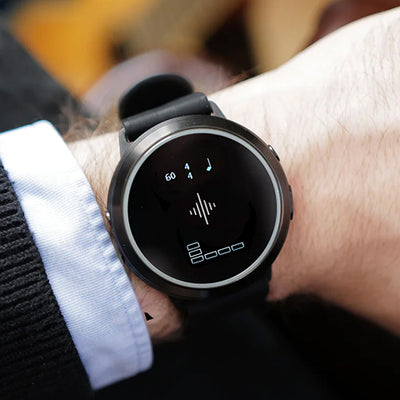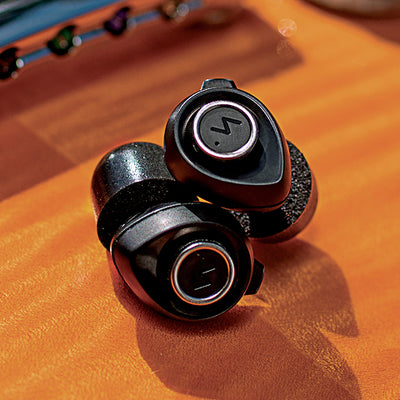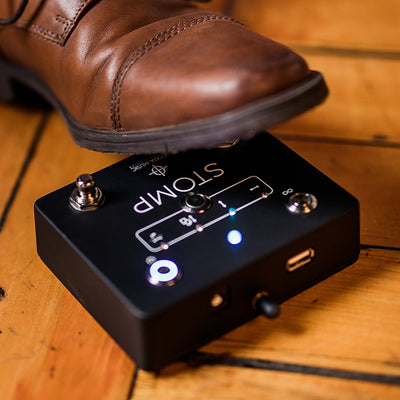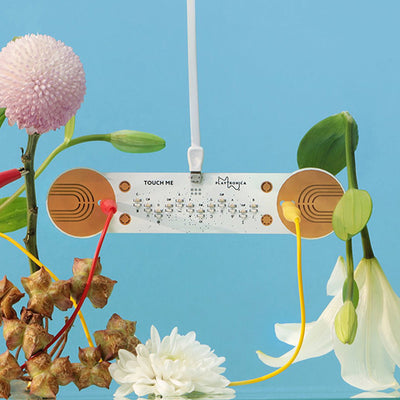Blog6 min read
5 innovative practice exercises you can only do with haptic tempo
Unlock new dimensions in timing, dynamics, and ensemble tightness with the vibration-powered Soundbrenner Pulse.

Why haptic > audible click
Unlike audible clicks that can get lost in noisy environments or contribute to ear fatigue, haptic feedback lets you feel the beat directly through your body. Research suggests that tactile cues can help musicians synchronize with equal or better accuracy than sound. The Soundbrenner Pulse offers vibrations up to 7× stronger than a smartphone motor - giving you a physical connection to tempo that opens new creative doors.
What you’ll need
-
A Soundbrenner Pulse (or Core 2 / Core Steel 2) paired with the Soundbrenner app
-
Optional body strap for alternate placements (like ankle or chest)
-
A quiet room or headphones for focus
Exercise 1: Dynamic phrasing crescendo/decrescendo drill
This drill helps you master volume shaping - without relying on your ears.
-
Set a tempo around 80 BPM with quarter-note vibrations.
-
Place the Pulse on your wrist.
-
Play eight measures very softly (pianissimo).
-
Over the next eight bars, gradually increase to very loud (fortissimo).
-
Then decrescendo over the next eight bars.
-
Repeat the cycle at different tempos.
Why it works: With no audible click, you train your internal sense of dynamic control through feel and breath, rather than sound.

Exercise 2: Gradual tempo-ramping ladder
This one builds expressive control over tempo changes.
-
In the app, use the “Incremental tempo change” feature.
-
Start at 60 BPM and set it to gradually increase by 1 BPM every 4 beats until it hits 100 BPM.
-
Then set a reverse ramp to slow back down to 60 BPM.
-
Play continuous scales or grooves throughout the ramp cycle.
Why it works: It trains your ability to stay relaxed and in control through natural tempo transitions - great for rubato, accelerando, and ritardando phrasing.
Exercise 3: Ensemble synchronization partner loop
Want to lock in tight with a bandmate?
-
Both players wear a Pulse (one on wrist, one on ankle, for example).
-
Create or join a synced session using the Soundbrenner multiplayer feature.
-
Trade 4-bar improvisations.
-
After each round, the leader taps a new tempo into the Pulse to start the next loop.
Why it works: Feeling a synchronized beat rather than hearing it frees up your ears for the music - and strengthens rhythmic communication in ensembles.
Exercise 4: Mixed-subdivision shuffle
This exercise builds advanced rhythmic awareness.
-
Set a base tempo (e.g., 100 BPM).
-
Use the app to program a custom vibration pattern: quarter notes → eighth-note triplets → sixteenth notes.
-
Loop the pattern and play rhythm exercises or drum rudiments that match each feel.
Why it works: The changing tactile subdivisions keep you alert and engaged, sharpening your ability to feel time in multiple layers.

Exercise 5: Silent downbeat challenge
A powerful test of your internal clock.
-
Program a repeating pattern with 3 vibration beats followed by 1 silent beat.
-
Play a groove or melody, keeping the rhythm flowing through the missing beat.
-
Gradually increase the number of silent beats in each cycle.
Why it works: With no click on certain beats, you’re forced to rely on internal timekeeping - a powerful skill for performance and improvisation.
Recap: Why this only works with haptics
These drills are uniquely effective because they remove sound from the equation and challenge your body and mind to feel time. Haptic practice:
-
Improves phrasing and dynamics
-
Helps you master smooth tempo changes
-
Strengthens ensemble lock-in
-
Trains subdivision fluency
-
Builds superior internal timekeeping
Final thought
Whether you’re a soloist, ensemble player, or bedroom producer, switching to haptic tempo will elevate your practice in ways you can’t hear - only feel. Try these five drills this week, and unlock a new level of musical precision.
Don't have a Soundbrenner wearable metronome yet? Check them out here.




























